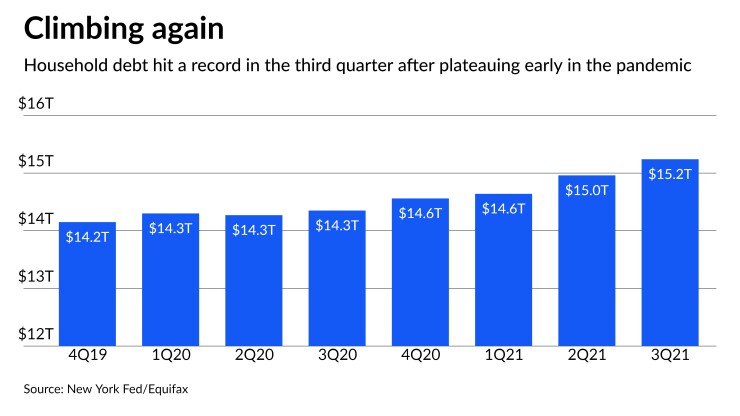The U.S. credit card industry finally appears to be turning a corner, with balances again rising after borrowers spent the pandemic’s earlier stages paying down their debt.
Card debt rose to $800 billion between July and September — a $17 billion increase that followed a similar rise in the prior quarter, according to new data from the Federal Reserve Bank of New York.
The upticks were “remarkable since they appear to be a return to the normal seasonal patterns in balances,” which usually rise ahead of a larger increase in the holiday shopping season, New York Fed researchers wrote in a

Credit card loan growth has lagged for much of the pandemic, as cardholders have used their increased savings and money from government relief programs to pay down balances. As the U.S. vaccination rate rises, bankers have been anticipating a rebound, hoping that new card borrowing will begin to outstrip paydowns of existing debt on a consistent basis.
Still, card balances in the third quarter remained $123 billion lower than they were at the end of 2019, underlining the extent to which consumers paid down their debt last year. The upcoming holiday season will be a test of how quickly borrowing will return to prepandemic levels, analysts say.
“Holiday spending is the real key,” said Bill Hardekopf, senior industry analyst for CardRates.com.
Overall, U.S. household debt rose to a record high of $15.24 trillion in the third quarter, up by $286 billion, or 1.9%, from the second quarter, according to the New York Fed’s quarterly household debt and credit report report.
Mortgage balances drove much of the increase, rising by $230 billion. Auto loans grew by $28 billion, primarily due to higher vehicle prices rather than an increase in the number of loans originated. Student loan balances were up by $14 billion.
After tightening their credit standards early in the pandemic, card issuers have shown a bigger appetite for new business this year. In the third quarter, the number of outstanding credit card accounts rose to nearly 520 million, up from more than 511 million in the second quarter and above prepandemic levels.
Gen Z borrowers, those born in 1995 or later, have increased their credit card borrowing by more than members of other generations, a recent
Major card issuers are engaged in an increasingly competitive battle for customers, launching new card options and improving their rewards to attract more business. JPMorgan Chase executives
“Competition has definitely intensified, especially in rewards,” Capital One Chairman and CEO Richard Fairbank said on the company’s earnings call last month. On Tuesday, McLean, Virginia-based Capital One
Lenders are also offering more credit cards to subprime borrowers after drastically pulling back in that segment early in the pandemic, the New York Fed’s report showed.
Payments on fewer card loans were classified as late during the third quarter, even as some pandemic-era assistance programs have lapsed, the report showed. About 4.3% of credit card debt was delinquent by 30 days or more in the quarter, down from 5.7% a year earlier, the report showed.





